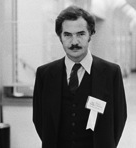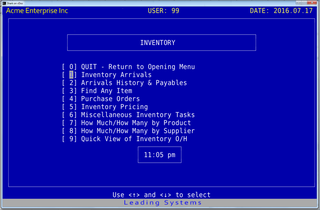Related Research Articles
Borland Software Corporation was a computing technology company founded in 1983 by Niels Jensen, Ole Henriksen, Mogens Glad, and Philippe Kahn. Its main business was developing and selling software development and software deployment products. Borland was first headquartered in Scotts Valley, California, then in Cupertino, California, and then in Austin, Texas. In 2009, the company became a full subsidiary of the British firm Micro Focus International plc. In 2023, Micro Focus was acquired by Canadian firm OpenText, which later absorbed Borland's portfolio into its application delivery management division.

Lotus 1-2-3 is a discontinued spreadsheet program from Lotus Software. It was the first killer application of the IBM PC, was hugely popular in the 1980s, and significantly contributed to the success of IBM PC-compatibles in the business market.
Clean-room design is the method of copying a design by reverse engineering and then recreating it without infringing any of the copyrights associated with the original design. Clean-room design is useful as a defense against copyright infringement because it relies on independent creation. However, because independent invention is not a defense against patents, clean-room designs typically cannot be used to circumvent patent restrictions.
Lotus Software was an American software company based in Massachusetts; it was sold to India's HCL Technologies in 2018.
Quattro Pro is a spreadsheet program developed by Borland and now sold by Alludo, most often as part of Alludo's WordPerfect Office suite.

Adam Osborne was a British author, software publisher, and computer designer who founded several companies in the United States and elsewhere. He introduced the Osborne 1, the first commercially successful portable computer.

The idea–expression distinction or idea–expression dichotomy is a legal doctrine in the United States that limits the scope of copyright protection by differentiating an idea from the expression or manifestation of that idea.

In software design, the look and feel of a graphical user interface comprises aspects of its design, including elements such as colors, shapes, layout, and typefaces, as well as the behavior of dynamic elements such as buttons, boxes, and menus. The term can also refer to aspects of a non-graphical user interface, as well as to aspects of an API – mostly to parts of an API that are not related to its functional properties. The term is used in reference to both software and websites.

Apple Computer, Inc. v. Microsoft Corporation, 35 F.3d 1435, was a copyright infringement lawsuit in which Apple Computer, Inc. sought to prevent Microsoft and Hewlett-Packard from using visual graphical user interface (GUI) elements that were similar to those in Apple's Lisa and Macintosh operating systems. The court ruled that, "Apple cannot get patent-like protection for the idea of a graphical user interface, or the idea of a desktop metaphor [under copyright law]...". In the midst of the Apple v. Microsoft lawsuit, Xerox also sued Apple alleging that Mac's GUI was heavily based on Xerox's. The district court dismissed Xerox's claims without addressing whether Apple's GUI infringed Xerox's. Apple lost all claims in the Microsoft suit except for the ruling that the trash can icon and folder icons from Hewlett-Packard's NewWave windows application were infringing. The lawsuit was filed in 1988 and lasted four years; the decision was affirmed on appeal in 1994, and Apple's appeal to the U.S. Supreme Court was denied.

Westlaw is an online legal research service and proprietary database for lawyers and legal professionals available in over 60 countries. Information resources on Westlaw include more than 40,000 databases of case law, state and federal statutes, administrative codes, newspaper and magazine articles, public records, law journals, law reviews, treatises, legal forms and other information resources.
Software copyright is the application of copyright in law to machine-readable software. While many of the legal principles and policy debates concerning software copyright have close parallels in other domains of copyright law, there are a number of distinctive issues that arise with software. This article primarily focuses on topics particular to software.
LexisNexis is an American data analytics company headquartered in New York, New York. Its products are various databases that are accessed through online portals, including portals for computer-assisted legal research (CALR), newspaper search, and consumer information. During the 1970s, LexisNexis began to make legal and journalistic documents more accessible electronically. As of 2006, the company had the world's largest electronic database for legal and public-records–related information. The company is a subsidiary of RELX.
Madster was a peer-to-peer file sharing service. It was released in Napster's wake in August 2000 and shut down in December 2002 as a result of a lawsuit by the Recording Industry Association of America.
MGM Studios, Inc. v. Grokster, Ltd., 545 U.S. 913 (2005), is a United States Supreme Court decision in which the Court ruled unanimously that the defendants, peer-to-peer file sharing companies Grokster and Streamcast, could be held liable for inducing copyright infringement by users of their file sharing software. The plaintiffs were a consortium of 28 entertainment companies, led by Metro-Goldwyn-Mayer studios.

VP-Info is a database language and compiler for the personal computer. VP-Info was a competitor to the Clipper and dBase applications in the late 1980s and 1990s. VP-Info was originally intended to run on MS-DOS, DR-DOS and the PC-MOS/386 operating system, but now is run in the vDOS, Windows environment. The last release of VP-Info, a multi-tasking, multi-user version released in 1992 was named SharkBase, or simply "Shark".
The multinational technology corporation Apple Inc. has been a participant in various legal proceedings and claims since it began operation and, like its competitors and peers, engages in litigation in its normal course of business for a variety of reasons. In particular, Apple is known for and promotes itself as actively and aggressively enforcing its intellectual property interests. From the 1980s to the present, Apple has been plaintiff or defendant in civil actions in the United States and other countries. Some of these actions have determined significant case law for the information technology industry and many have captured the attention of the public and media. Apple's litigation generally involves intellectual property disputes, but the company has also been a party in lawsuits that include antitrust claims, consumer actions, commercial unfair trade practice suits, defamation claims, and corporate espionage, among other matters.
Lotus Dev. Corp. v. Borland Int'l, Inc., 516 U.S. 233 (1996), is a United States Supreme Court case that tested the extent of software copyright. The lower court had held that copyright does not extend to the user interface of a computer program, such as the text and layout of menus. Due to the recusal of one justice, the Supreme Court decided the case with an eight-member bench split evenly, leaving the lower court's decision affirmed but setting no national precedent.

Structure, sequence and organization (SSO) is a term used in the United States to define a basis for comparing one software work to another in order to determine if copying has occurred that infringes on copyright, even when the second work is not a literal copy of the first. The term was introduced in the case of Whelan v. Jaslow in 1986. The method of comparing the SSO of two software products has since evolved in attempts to avoid the extremes of over-protection and under-protection, both of which are considered to discourage innovation. More recently, the concept has been used in Oracle America, Inc. v. Google, Inc.
Open source license litigation involves lawsuits surrounding open-source licensed software. Many of the legal rights of open source software licensors enforceable against users violating licensing agreements are untested by the U.S. legal system. Free and open source software (FOSS) is distributed under a variety of free-software licenses, which are unique among other software licenses. Legal action against open source licenses involves questions about their validity and enforceability.
References
- ↑ "A DIVISIVE LOTUS 'CLONE' WAR" . The New York Times . February 5, 1987.
- ↑ "Three Officials Quit Paperback" . The New York Times . June 15, 1988.
- ↑ "VP-Expert".
- ↑ "Paperback Software International".
- ↑ "Lotus Wins Copyright Decision" . The New York Times . June 29, 1990.
- ↑ John Markoff (July 3, 1990). "Lotus Sues 2 On Copyright Violation" . The New York Times .
- ↑ bsobel (January 19, 2015). "Lotus Development Corp. v. Paperback Software International". H2O. H2O. Retrieved May 29, 2016.
- ↑ Gerard J. Lewis (1991). "COMMENT: LOTUS DEVELOPMENT CORP. V. PAPERBACK SOFTWARE INTERNATIONAL: BROAD COPYRIGHT PROTECTION FOR USER INTERFACES IGNORES THE SOFTWARE INDUSTRY'S TREND TOWARD STANDARDIZATION". LexisNexis. LexisNexis. Retrieved May 29, 2016.
- ↑ Brian Johnson. "An Analysis of the Copyrightability of the "Look and Feel" of a Computer Program: Lotus v. Paperback Software" (PDF). The Ohio State University Law Review. hdl:1811/64566 . Retrieved May 29, 2016.
- ↑ Pamela Samuelson (1992). "Computer Programs, User Interfaces, and Section 102(b) of the Copyright Act of 1976: A Critique of Lotus v Paperback". Duke Law. Duke Law. Retrieved May 29, 2016.
- ↑ "InfoWorld VP Planner Product Review". InfoWorld . 2 April 1990.
- ↑ Russo, J. and J. Nafziger. "Software 'Look and Feel' Protection in the 1990s"
- ↑ Lotus Dev. Corp. v. Paperback Software Int'l, 740 F. Supp. 37 (D. Mass. 1990)
- ↑ "Action in Lotus's Lawsuit". The New York Times .
- ↑ "LOTUS DEVELOPMENT CORP. v. BORLAND INTERNATIONAL INC., 49 F.3d 807 (1st Cir. 1995)". Cornell Law. Retrieved May 29, 2016.[ failed verification ]
- ↑ VP-Info